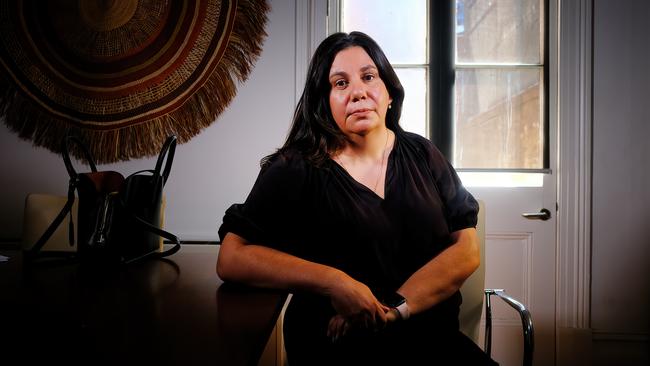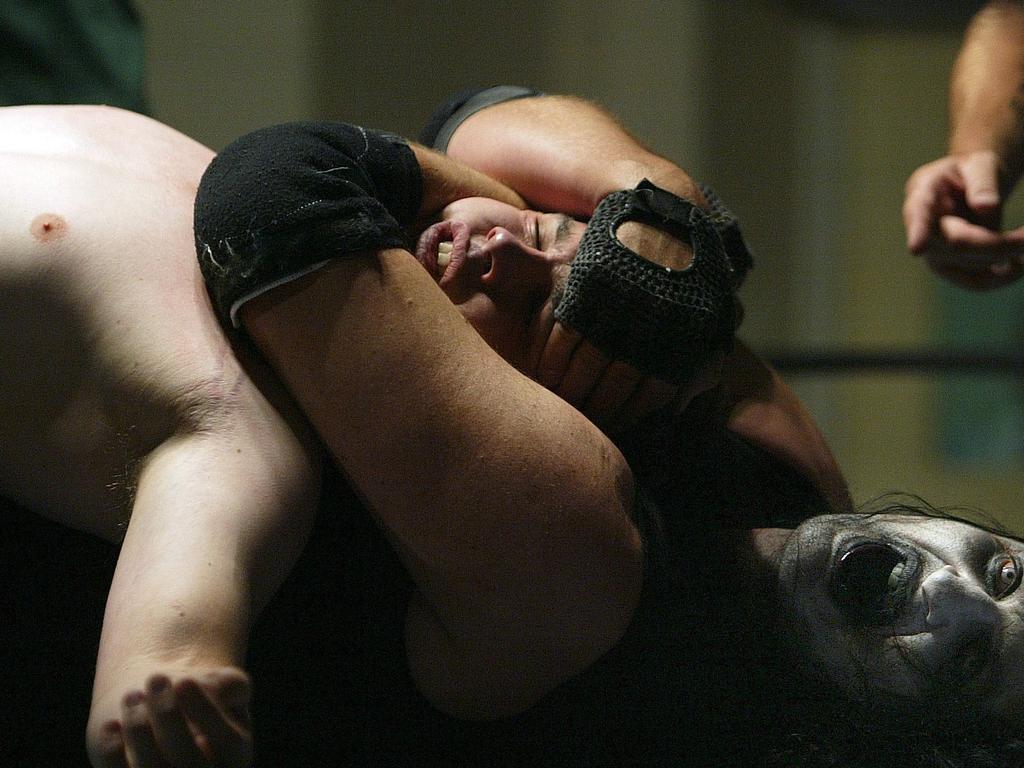Queensland Aboriginal man died after cop used neck restraint
A young Aboriginal man died resisting arrest after a Queensland police officer used a controversially endorsed stranglehold banned across the rest of Australia, according to an autopsy report.

A young Aboriginal man died resisting arrest after a Queensland police officer used a controversially endorsed stranglehold banned across the rest of Australia, according to an autopsy report and evidence given to an internal police investigation.
Steven Nixon-McKellar, 27, had the drug ice in his system and was at the wheel of a stolen car carrying a cousin and mate in the front yard of his aunty’s house in Toowoomba on October 7, 2021, when confronted by two officers who boxed them in with their police sedan.
The engine was running – according to an officer’s recorded account soon after the incident and heard by The Weekend Australian – and Nixon-McKellar ignored police demands to “get out of the car” as he reversed, with one officer saying he had been hit by the car door.
In the recorded account, one of the officers says he smashedthe driver’s window using his baton, and that Nixon-McKellar charged out of the passenger side of the stolen Subaru at police while the other two ran away.
“I couldn’t Taser him … couldn’t spray … just couldn’t get hold of him, he sort of half put me in a headlock at one point,’’ the officer says in the recording.
A neighbour told The Weekend Australian how the two officers and Nixon-McKellar then wrestled for the next few minutes in a “standing rugby league tackle” that moved out to the footpath.
A police body-worn camera captures Nixon-McKellar grabbing at the police batons – crying out “help me, help me” – as the officers deliver their blows, yelling for him to “get on the ground”.
According to a recorded interview with his family, police investigating the death-in-custody said that a third officer arrived responding to a call for back-up and used the neck restraint on him.
Within seconds, the grandson of one of Queensland’s revered Aboriginal elders lay dead.
Police initially released a public statement about the incident at Stone St, in the Toowoomba suburb of Wilsonton – even before confirming his death to the family – that when “officers attempted to arrest the 27-year-old man, he suffered a medical episode and was declared deceased at the scene’’.
Later that day, the Queensland Police Service’s assistant commissioner, Mike Condon, fronted a press conference saying there had been a “violent struggle” but made no mention of the stranglehold being used on Nixon-McKellar before he died.
“During an altercation with police (Nixon-McKellar) became unconscious,’’ he said.
Now, 18 months later, it can be revealed Nixon-McKellar had a cardiac arrest when an officer used a Queensland Police-approved “Lateral Vascular Neck Restraint” on him.
An internal police investigation, which analysed body-cam footage, estimated the officer squeezed his neck for 11 seconds before he dropped to the ground and died, with police attempts at CPR unsuccessful.

At the time of his death, Nixon-McKellar – a diagnosed paranoid schizophrenic – was ill; having being treated in hospital for asthma only days before with a subsequent autopsy finding he had undiagnosed heart and lung disease.
Toxicology tests detected methamphetamine (ice) in his body.
The autopsy report, written by Queensland Health forensic pathologist Christopher Day and obtained by The Weekend Australian, also drew on dash-camera footage from the police patrol car, which shows “a struggle” between the two officers and Nixon-McKellar with “all three remaining standing throughout”.
Dr Day said a third officer enters the footage and “places his arm around the deceased neck”.
“In summary this young man died suddenly and unexpectedly whilst being forcibly restrained by Police officers,” Dr Day’s report concludes.
“Supplied footage showed a prolonged restraint/altercation in which he collapsed almost immediately following pressure being applied to his head and neck region. The presence of bruising is in keeping with forceful application of trauma to the side of the neck, as may be encountered in a lateral neck hold.”
The autopsy found that while the precise cause of death could not be determined, the officer’s use of the LVNR contributed.
“Death has most likely resulted from a combination of all the above factors, being physical and psychological exertion related to the restraint, brief pressure applied to the neck, stimulant drug intoxication, asthma, bronchopneumonia and coronary atherosclerosis.
“The precise mechanism of death cannot be determined at autopsy examination. Given the close temporal relationship between pressure being applied to the neck and cardiac arrest, it is considered a significant contributory factor.”
Banned in every other jurisdiction in Australia, Queensland Police are trained to use the LVNR that, according to its Operational Procedures Manual, involves compressing the arteries and veins in the neck so as to cut-off the blood supply to the brain, leading “to altered levels of consciousness”.
The martial arts-inspired technique – which is variously called a stranglehold or sleeper hold – is gradually being outlawed across the world with US police departments increasingly abandoning the practice.
Mother of Aboriginal man killed during Queensland arrest
An investigation by The Weekend Australian can reveal the circumstances around the death of Nixon-McKellar that raises questions about whether police breached the rules that allow for the use of the restraint on him.
It can also be revealed that in the months after he died, Queensland Police began a secret review into the continued use of the LVNR that had been ordered by the state coroner after the 2018 death in Townsville of another Aboriginal man, 39-year-old Trevor King, also known as Noombah, on who police had unsuccessfully attempted to apply the restraint.
The “LVNR working group”, which included senior police and representatives of the police union, Crime and Corruption Commission and ambulance service, canvassed the views of other state jurisdictions and the Australian Federal Police on the restraint.
Leaked documents from the working group show that as of last September, all but NSW police had responded with their opposition to the use of the LVNR.
“Unanimously the 6 jurisdictions that replied to the request for information (WA, SA, VIC, NT, Tas, AFP) were all in agreement that they do not teach, nor include the LVNR in their Use of Force continuums, nor do they train them for in-extremis circumstances,” a report prepared for the review said.
“Additionally, it appears that all of the above Police organisations also strongly discourage the use of the LVNR, with several implying that it can open up civil litigation recourse to its members.’’
NSW police has since confirmed that LVNR is “not a technique within NSWPF’s weaponless control training”.
A majority of the working group voted in November to retain use of the LVNR but ordered a more detailed 12-month review into the technique.
According to the leaked documents, the medical director of the Queensland Ambulance Service, Stephen Rashford, told the working group “there was limited literature, and the reality was the LVNR procedure has been stopped over several jurisdictions due to political and community sentiment rather than empirical data to suggest the outcomes are directly related to it”.
The documents from the working group show senior Queensland police warned of the dangers in the use of the LVNR and that in a “dynamic operational environment if not used in its perfect form, there was a high risk of unacceptable injury”.
Queensland police are trained every year to “apply the hold from behind the subject person only” and “immediately cease maximum compression” if the person complies or “loses consciousness”.
After viewing footage from police body-worn cameras in the Nixon-McKellar incident, Queensland Police’s head of Operational Training Services, Inspector Anthony Buxton, told other members of the working group “it was hard to see on BWC (body-worn cameras) if (LVNR) was applied correctly in that dynamic environment”.
The police manual states the LVNR should not be used unless the situation is a “high risk” and there is an immediate operational necessity or officers are acting in self-defence.
Nixon-McKellar’s mother, Raelene Nixon, andother members of her family have been shown some of the footage (but not of the initial confrontation beside the car) and told The Weekend Australian it didn’t show her son being violent towards police.
Dr Nixon, a lecturer in rural Aboriginal health at the University of Melbourne, says her son was too weak to pose a threat.
“He didn’t run because he was sick from asthma, he’d only just been in hospital,’’ she said.
“Steven looked scared, he didn’t strike out at them, he was hit with the batons and even kicked and he was just trying to grab the batons so they would stop hitting him.
“If he was being violent why would he be crying out for help?”
Dr Nixon, whose mother Lynette Nixon was named Australia’s 2018 Aboriginal Elder of the Year, believes police used “disproportionate force on him because he was Aboriginal”.
“This officer comes in from the side and puts him in this hold, I think he died instantly, his eyes were open when he fell to the ground and as they cuffed him,’’ she said.
In a recorded interview between the family and police ethical standards command’s David Cousins, who investigated the death, it was revealed police went to the Toowoomba home because of a report of a “suspected stolen car”.
Detective Senior Sergeant Cousins told the family that footage showed the car moved only “slightly” when police arrived: “And I’m not talking about reversing, going forward, I’m talking little tiny steps.”
He said the LVNR had been used briefly on Nixon-McKellar – who had previously served time in prison for car theft – and that police didn’t know who he was before attempting to arrest him.
Stewart Levitt, the lawyer who will represent Dr Nixon at the coronial inquest into her son’s death – with a date yet to be fixed – told The Weekend Australian that the LVNR should not have been used.
“I find it extraordinary that the police in Queensland who are armed, who have batons, who don’t work alone, use such excessive force to apprehend people in circumstances where they hold the balance of power,’’ he said.
“The police should assume that the individual has underlying health conditions because they have no reason to assume that they do not, and the failure to do so contributes to, or causes, death.”
The Queensland Police Service, in response to a series of questions about Nixon-McKellar’s death or use of LVNR, said it could not provide comment while the death in custody was before the Coroner.
“The matter referenced was investigated by the Queensland Police Service Ethical Standards Command on behalf of the State Coroner, and was subject to oversight by the Crime and Corruption Commission,” a statement said.
“Inherent in any police interaction with the community, is the underlying risk that a situation may be immediately volatile, and rapidly escalate to a violent confrontation to which the officer must quickly respond.”




